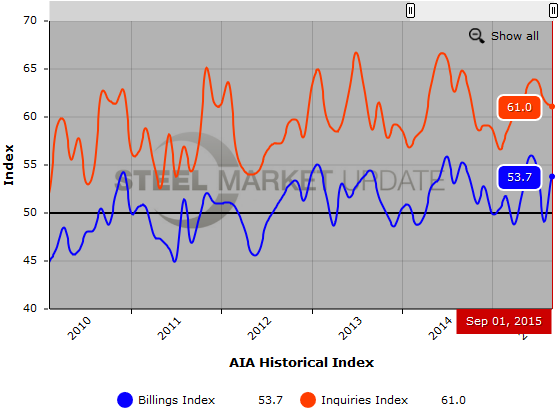Economy

ABI Rebounds in September
Written by Sandy Williams
October 22, 2015
The September Architecture Billings Index rebounded from August’s dip into negative territory. September’s ABI score was 53.7 up from 49.1 the previous month, continuing the see-saw pattern the index has shown throughout 2015.
“Aside from uneven demand for design services in the Northeast, all regions are project sectors are in good shape,” said AIA Chief Economist Kermit Baker, Hon. AIA, PhD. “Areas of concern are shifting to supply issues for the industry, including volatility in building materials costs, a lack of a deep enough talent pool to keep up with demand, as well as a lack of contractors to execute design work.”
The design contracts index was at 53.2 in September.
Regionally, the South, Midwest and West all posted above the 50 neutral point in September. The Northeast, however, continued to show weak business conditions. The regional averages were: South (54.5), Midwest (54.2), West (51.7), Northeast (43.7).
The breakdown by sector was: mixed practice (52.6), institutional (51.5), commercial / industrial (50.9) multi-family residential (49.5).
The ABI, a diffusion index published monthly by the American Institute of Architects, reflects the nine to twelve month lead time between architecture billings and nonresidential construction spending. A score above 50 indicates an increase in billings. The regional and sector categories are calculated as a 3-month moving average, whereas the national index, design contracts and inquiries are monthly numbers.
Below is a graph showing the history of The Architecture Billings Index. You will need to view the graph on our website to use it’s interactive features, you can do so by clicking here. If you need assistance with either logging in or navigating the website, please contact our office at 800-432-3475 or info@SteelMarketUpdate.com.

Sandy Williams
Read more from Sandy WilliamsLatest in Economy

Architecture billings continue to slide in March
Architecture firms said billings continued to decline in March, according to the latest Architecture Billings Index (ABI) released by the American Institute of Architects (AIA) and Deltek.

Beige Book shows concerns about trade policy
Manufacturing was mixed, but two-thirds of districts said activity was little changed or had declined.

New York state manufacturing index drops again in April
Firms were pessimistic, with the future general business conditions index falling to its second lowest reading in the more than 20-year history of the survey

Construction adds 13,000 jobs in March
The construction sector added 13,000 jobs, seasonally adjusted, in March, but tariffs could undermine the industry.

Supply chains, end-users brace for impact from tariffs
Supply chains are working through what the tariffs mean for them

